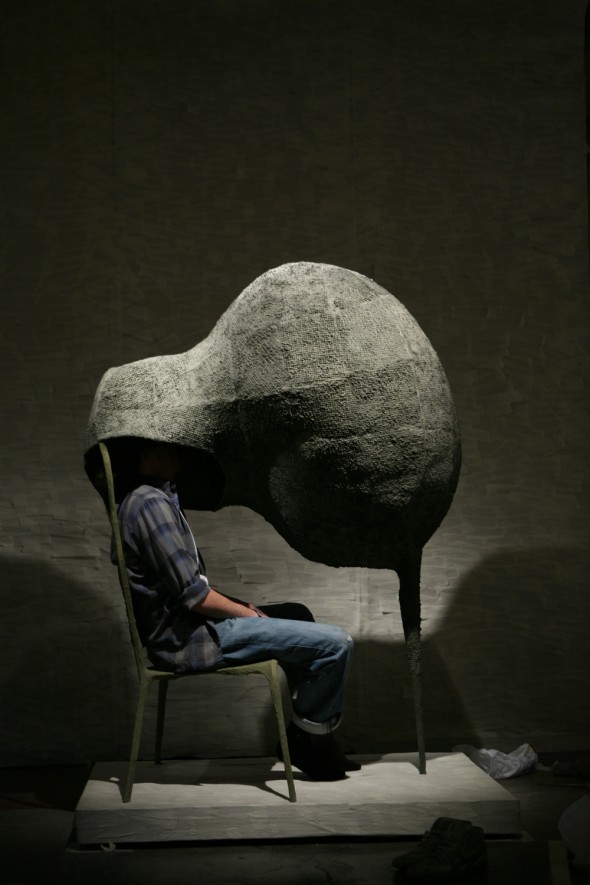
Nacho sitting on his new "Evolution Chair"
Perhaps it’s the fact that his studio is located in a 20th century church in Eindhoven, Netherlands, that makes his designs somehow cooler than the majority of recent design graduate students. Or maybe it is the fact that he has a vision, and fathoms it in a way that most young artists are still learning— and yearning—to do that makes his ethereal designs stand out. It doesn’t really matter how you spin it, Spanish-born Nacho Carbonell’s celestial and heady designs are echoing throughout the design arena.
After attending high school in Valencia, Spain, Carbonell stayed with a foreign exchange host family in Goshen, Indiana. While middle America might not conjure up otherworldly avant-garde designs, for Carbonell, it turned out to be a mecca of sorts—a place where his hands finally started to create the images in his mind. He audited high school classes in ceramics, photography, and woodworking, and his fervor for design developed as he returned to Spain with a newfound curiosity. He would go on to attend Cardenal Herrera CEU and then study at the Design Academy Eindhoven in the Netherlands, where he now resides and works.
Carbonell approaches design as if chairs and interior objects are actually living organisms. “My work is a combination of nature, human aspects, and the way we live in society,” he says. “All of my work is connected. I try to give character to my projects, and it brings them alive.”
His work also embraces a world of fantasy that is not only visually stimulating, but is also emotionally touching. He is stirred not only by our natural world, but also by human behavior. “I am very inspired by traveling. When immersed in different cultures, things get lost in translation, so I try to picture it as a whole and form my own image of society and different cultures,” he says. In this way, Carbonell’s work serves as an extension of what he has seen during his globe-trotting—ideas that can speak to an international audience.
“Evolution” is a series of chairs Carbonell designed in order for one to escape “the chaos and frenzy of our modern world.” In order to give this impression, he has created designs that have an interactive quality that connects the viewer to the piece in a very natural way. For instance, Carbonell engaged recycled newspaper for his current series.
“The media is constantly pushing us with information, molding our minds,” he says. “I wanted to create an escape from the media.” Carbonell’s materials reflect this. Recently he used papier-mâché pasted over iron frames covered with chicken wire, creating a cocoon-like structure attached to the seat. The “one man” chair seems to provoke introspection and meditation, while “the cocoon” allows shelter for someone who wishes to sit in their thoughts. In total, there are three pieces in the series: the “one man chair,” “the bench,” and “the lovers’ chair,” which explores different ways of communication in the form of a connecting tunnel.
Thus far, this visionary has won numerous awards, including the prestigious INJUVE Award for Young Creation in Spain in 2006, an honor that recognizes his inimitable approach to design. But despite the fame, Carbonell’s vision hasn’t been compromised by any commercial success, and he continues to exemplify his ingenuity with recent projects such as “Skin,” presented during Milan Design Week this year. The furniture in the series, with a literal rubber skin that stretches to cover the objects within, was inspired by a story in the children’s book The Little Prince, when a boa constrictor swallowed an elephant and all that remained of the elephant was its shape beneath the snake’s skin.
Carbonell says, “People hide messes underneath beds. I wanted to find these aspects in my furniture. When furniture has this skin, it becomes functional and people can hide things in them.” The layers then acclimatize to take the form of the object, creating impetuous contours, while the furniture remains unconventionally tall and fantastical. It’s the wonder of what is beneath that peaks the viewer’s curiosity.
In this way, viewers can experience a playful personality and knowing observations on life throughout Carbonell’s relics. They are communicative objects, ones you want to be able to feel; not just stare at. For Carbonell, art is not only something organic and beautiful— viewers should be able to interact with it and touch it. Carbonell says, “Art is seen as nonfunctional. It gives a message. My work is functional. It’s a hybrid between art and design.”
– Lena Vazifdar

